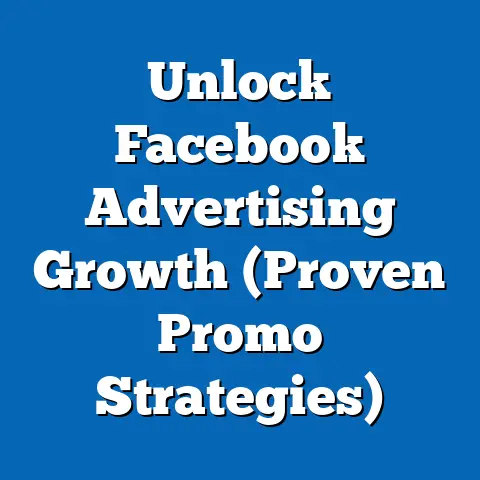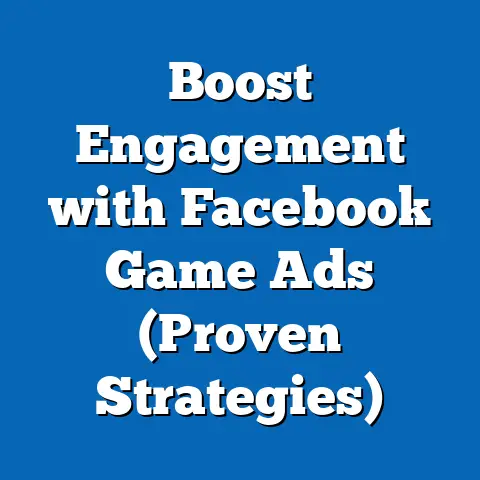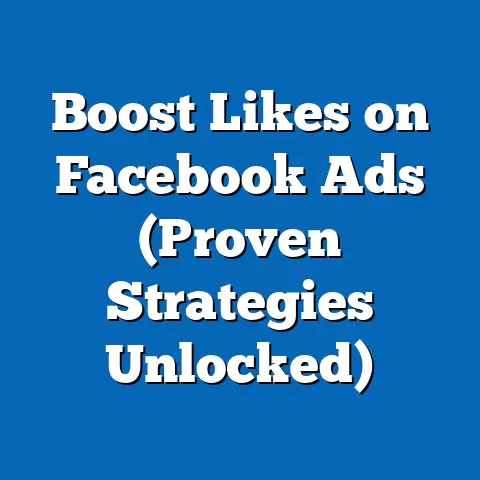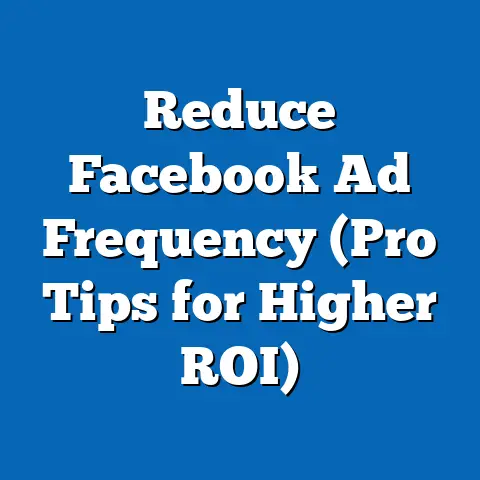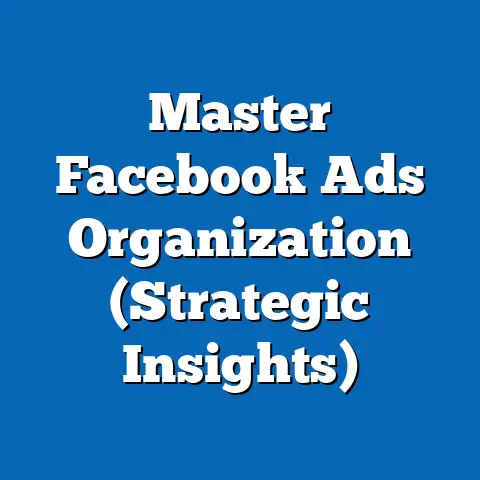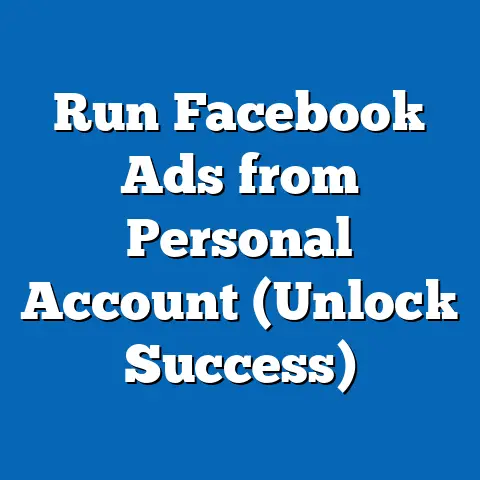Outsmart Facebook Ads Competitors (Proven Strategies)
In the ever-evolving world of digital marketing, mastering Facebook Ads has become a critical skill for businesses aiming to capture audience attention and drive conversions. With over 2.9 billion monthly active users as of 2023, according to Meta’s official reports, Facebook remains one of the most powerful advertising platforms globally. However, the sheer volume of advertisers—over 10 million active ad accounts as reported by Hootsuite in 2023—creates fierce competition, making it essential to craft strategies that stand out.
The Craftsmanship of Facebook Advertising: Key Statistics and Trends
Facebook Ads are not just about throwing money at a campaign; they require meticulous craftsmanship to yield results. According to a 2023 report by Statista, global advertising revenue on Facebook reached approximately $131.9 billion in 2022, underscoring the platform’s dominance in the digital ad space. This figure represents a 12% increase from 2021, highlighting a consistent upward trend in ad spending despite economic uncertainties.
Competition is intensifying as businesses of all sizes—from small startups to multinational corporations—vie for user attention. A study by WordStream in 2023 revealed that the average cost-per-click (CPC) for Facebook Ads across industries is $1.72, a 15% increase from 2021’s average of $1.49. This rising cost signals the importance of strategic ad placement and optimization to maximize return on investment (ROI).
Demographically, Facebook’s user base is diverse, offering advertisers a wide range of targeting options. As of 2023, Meta reports that 56.8% of users are male, while 43.2% are female, with the largest age group being 25-34 years old, accounting for 31.5% of the total user base. Geographically, India leads with over 314 million users, followed by the United States with 179 million, per Statista data. These demographic insights are crucial for tailoring campaigns to specific audiences and outmaneuvering competitors who may overlook nuanced targeting.
Historically, Facebook Ads have evolved from basic image posts to sophisticated formats like video ads, carousel ads, and interactive Stories. A 2022 report by Social Media Examiner noted that video ads now account for 43% of ad impressions on the platform, up from 28% in 2019, reflecting a shift toward dynamic content. Staying ahead of such trends is vital for crafting campaigns that resonate with users and cut through the noise of competitor ads.
Understanding the Competitive Landscape
Before diving into specific strategies, it’s essential to understand the competitive landscape of Facebook Ads. With millions of advertisers, the platform’s auction-based system means that ad placement is determined by a combination of bid amount, ad relevance, and estimated action rates. According to Meta, ads with higher relevance scores (based on user engagement and feedback) are prioritized, often at a lower cost per impression.
A 2023 analysis by AdEspresso found that industries like finance and insurance face the highest CPCs, averaging $3.77, while retail and e-commerce hover around $0.70. This disparity illustrates how competition varies by sector, requiring tailored approaches to budgeting and targeting. For instance, e-commerce businesses may focus on high-volume, low-cost clicks, while finance advertisers might prioritize quality leads over quantity.
Competitor analysis is a cornerstone of outsmarting rivals. Tools like Facebook’s Ad Library allow you to view active ads from any business page, offering insights into their messaging, visuals, and audience targeting. A 2022 survey by HubSpot revealed that 68% of marketers use competitor ad analysis to refine their campaigns, a tactic that can reveal gaps in their strategies and opportunities for differentiation.
Proven Strategy 1: Hyper-Targeted Audience Segmentation
One of the most effective ways to outsmart competitors is through hyper-targeted audience segmentation. Facebook’s robust targeting options allow advertisers to reach users based on demographics, interests, behaviors, and even life events. A 2023 report by eMarketer found that campaigns using detailed targeting options see a 37% higher click-through rate (CTR) compared to broader audience settings.
Start by creating custom audiences using data from your website visitors, email lists, or app users. Meta’s data indicates that custom audiences can boost conversion rates by up to 50% compared to generic targeting. For example, retargeting users who abandoned their shopping carts with a personalized discount ad can recover lost sales—a tactic used by 72% of e-commerce businesses, per a 2022 Shopify study.
Lookalike audiences are another powerful tool. By leveraging Facebook’s algorithm to find users similar to your best customers, you can expand your reach without sacrificing relevance. A case study by Hootsuite in 2023 showed that lookalike audiences delivered a 2.5x higher ROI compared to interest-based targeting for a mid-sized retail brand.
Demographic differences also play a role in segmentation. For instance, younger users (18-24) are more likely to engage with Stories ads, with a 2023 Sprout Social report noting a 62% engagement rate for this format among Gen Z. In contrast, users aged 35-54 prefer in-feed video ads, highlighting the need to align ad formats with audience preferences.
Proven Strategy 2: Crafting Compelling Ad Creatives
In a crowded ad space, creativity is your differentiator. A 2023 study by Nielsen found that ad creative quality accounts for 49% of a campaign’s impact on sales, far outweighing factors like reach (22%) or targeting (15%). Competitors who rely on generic visuals or copy are easily overlooked, making unique and engaging content a must.
Video content reigns supreme on Facebook. According to Meta, video ads generate 6.09% higher engagement rates than static image ads. Keep videos short—under 15 seconds for Stories and under 30 seconds for in-feed ads—as attention spans wane quickly; a 2022 Vidyard report noted that 60% of viewers drop off after the first 30 seconds.
Copywriting is equally critical. Use action-oriented language and address pain points directly. A/B testing by WordStream in 2023 showed that ads with clear calls-to-action (CTAs) like “Shop Now” or “Learn More” achieve a 28% higher CTR than vague phrases. Additionally, incorporating user-generated content (UGC) can build trust; a 2022 Stackla survey found that 79% of consumers trust UGC more than brand-created content.
Visualize this data with a bar chart comparing engagement rates across ad formats: video ads at 6.09%, image ads at 4.2%, and carousel ads at 5.1%. Such a chart would highlight the clear advantage of video in capturing attention amidst competitor noise.
Proven Strategy 3: Optimizing Ad Spend with Data-Driven Decisions
Budget optimization is where many advertisers falter, giving savvy competitors an edge. Facebook’s Campaign Budget Optimization (CBO) tool automatically allocates spend to the best-performing ad sets, and a 2023 report by Socialbakers found that campaigns using CBO saw a 22% reduction in cost per acquisition (CPA) compared to manual budgeting.
Historical trends show that ad costs fluctuate seasonally. For instance, CPCs spike by 25-30% during the holiday season (November-December), per a 2022 AdEspresso analysis, as competition intensifies. Planning campaigns outside peak periods or focusing on niche holidays can reduce costs while maintaining visibility.
Demographic spending patterns also matter. A 2023 report by Statista noted that advertisers targeting users aged 18-24 often face higher CPMs (cost per thousand impressions) due to intense competition for this group. Shifting focus to less-saturated demographics, like users aged 45-54, can lower costs; CPMs for this group are 18% below the platform average.
Use Facebook’s Ads Manager to track metrics like CTR, CPA, and ROAS (return on ad spend). Regularly analyze these metrics to identify underperforming ads and reallocate budgets. A 2022 case study by HubSpot showed that brands adjusting budgets weekly based on performance data improved ROAS by 35% over static campaigns.
Proven Strategy 4: Leveraging Advanced Tools and Automation
Automation is a game-changer for staying ahead of competitors. Facebook’s Dynamic Ads automatically tailor content to individual users based on their browsing history, and a 2023 report by Meta revealed that Dynamic Ads achieve a 34% higher conversion rate than standard ads. This is particularly effective for e-commerce, where product catalogs can be dynamically showcased.
Third-party tools like AdEspresso or Revealbot can further streamline campaign management. These platforms offer features like automated A/B testing and competitor benchmarking. A 2022 survey by Marketing Land found that 64% of advertisers using automation tools reported a 20% or greater increase in campaign efficiency.
Artificial Intelligence (AI) is also reshaping ad strategies. Tools powered by AI can predict optimal bid amounts and audience segments. For instance, a 2023 study by Forrester noted that AI-driven ad platforms reduced CPA by 19% for businesses in competitive sectors like tech and finance.
However, automation must be balanced with human oversight. Over-reliance on algorithms can lead to misaligned messaging, as seen in a 2022 incident where automated ads for a fitness brand targeted irrelevant audiences, resulting in a 40% drop in CTR. Regular manual checks ensure campaigns remain on-brand and relevant.
Proven Strategy 5: Staying Ahead with Continuous Testing and Learning
The digital ad landscape evolves rapidly, and continuous testing is non-negotiable. A/B testing different ad elements—headlines, images, CTAs—helps identify what resonates most with your audience. A 2023 Optimizely report found that campaigns running at least one A/B test per month saw a 27% higher CTR compared to those without testing.
Historical data shows the value of iteration. In 2018, only 45% of marketers regularly tested ad variations, per a Social Media Examiner survey, compared to 73% in 2023. This shift reflects growing recognition of testing as a competitive necessity.
Demographic responses vary, requiring tailored tests. For example, a 2023 Sprout Social study noted that Gen Z users respond 40% more favorably to humorous ad copy, while Baby Boomers prefer straightforward, value-driven messaging. Testing across age groups ensures your ads appeal to diverse segments.
Track long-term trends using Facebook Insights and Google Analytics. Visualize test results with line graphs showing CTR or conversion rates over time for different ad variations. Such visuals can reveal patterns, like seasonal spikes or format preferences, that competitors might miss.
Broader Implications and Future Trends
Outsmarting competitors on Facebook Ads is not just about short-term wins; it’s about building sustainable strategies in a dynamic environment. The platform’s continued growth—Meta projects reaching 3 billion monthly users by 2025—means competition will only intensify. Rising CPCs (up 15% since 2021) and evolving user behaviors, like the shift to video and Stories, signal the need for agility.
Demographic shifts also warrant attention. As younger users gravitate toward platforms like TikTok (with 1.2 billion users as of 2023, per Statista), Facebook’s older user base is growing; the 55+ age group increased by 8% from 2021 to 2023. Advertisers must adapt to these changes, potentially focusing on formats and messaging that appeal to mature audiences.
Emerging technologies, like AI and augmented reality (AR) ads, offer new frontiers. Meta’s 2023 rollout of AR ad formats saw a 94% higher engagement rate in early trials, per company data. Staying ahead of such innovations can provide a first-mover advantage over competitors slow to adapt.
In conclusion, outsmarting Facebook Ads competitors requires a blend of precision targeting, creative excellence, budget optimization, automation, and relentless testing. By leveraging data-driven insights and staying attuned to trends, businesses can carve out a competitive edge in this crowded space. The broader implication is clear: success on Facebook Ads is not a one-time achievement but a continuous journey of learning and adaptation.

